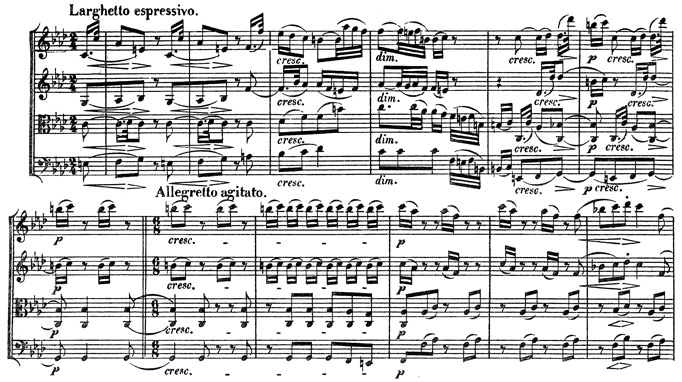Ludwig van Beethoven
String Quartet in F minor op.95, “Serioso“
Media Review / Comparison
2012-03-08 — Original posting (on Blogger)
2012-11-04 — Metronome table added, Endellion String Quartet added
2013-08-06 — New standard layout applied
2013-10-12 — Added Chiaroscuro Quartet, minor amendments
2014-11-06 — Re-posting as is (WordPress)
2016-07-09 — Brushed up for better readability
Table of Contents
Introduction / The Recordings
Here’s another note on the recordings of Beethoven’s string quartets in my music collection, about the quartet in F minor op.95 — references to the CDs are given at the bottom of the respective section, or in one of the related postings, or see the summary on the postings covering Beethoven’s String Quartets. Here’s a short list of the recordings in this comparison, in alphabetic order:
- Amadeus Quartet (1960)
- Artemis Quartet (2005)
- Busch Quartet (1932)
- Chiaroscuro Quartet (2012)
- Emerson String Quartet (1997)
- Endellion String Quartet (2008)
- Guarneri String Quartet (1968)
- Melos Quartett (1984)
- Quartetto Italiano (1971)
- Takács Quartet (2004)
The Composition
The String Quartet in F minor, op.95 (“Serioso”) by Ludwig van Beethoven (1770 – 1827) features the following movements:
1. Allegro con brio (4/4)
2. Allegretto ma non troppo (2/4)
A remark about the tempo: a proper Allegretto (even with “ma non troppo“) implies “faster than Andante” (i.e., probably around 80 – 100 beats per minute) — and can’t be realized based on quarter notes: all ensembles in this selection (with one exception) play roughly between 1/4=55 and 1/4=61. I think the key from this annotation is that the movement should not be static (let alone “slow”), but retain some motion, going forward.
3. Allegro assai vivace ma serioso (3/4) — Più Allegro (3/4)
This movement has two highly contrasting faces: the forte parts with their punctuations, very virtuoso, The first forte part is repeated, then it returns in the middle of the movement, and the last part is a short, even faster (Più Allegro) version of the same. Between these forte sections there are two espressivo intermezzi, all p/pp, without tempo indication. Most ensembles slow down a bit for the espressivo, but this should not be exaggerated — not just because there is no tempo indication, but because the calm, serene atmosphere is in the composition, in the long notes of the melody, played by the three lower voices. The figures in the first violin are not melody, but merely ornament.
4. Larghetto espressivo (2/4) — Allegretto agitato (6/8) — Allegro (alla breve, 2/2)
Timing Comparison
As one of the few things that one can actually “measure” in music performances, I’m giving the approximate metronome numbers for each of the movements in the text below.
As these numbers are spread over the text, I felt it would help if I collected them in a table, shown below. I have used color coding to indicate relative rates: white would be the average tempo, blue fields are slower tempi, green indicates faster-than-average performances (where the strength of the color indicates the amount of deviation from the average). Some ensembles prefer slower tempi, others are faster throughout, some are “mixed bags” (click on table for full size view):
The metronome numbers for the second movement, as well as for the first and the last segment in the last movement were calculated from the overall duration (i.e., they are the average over the entire section or movement). All numbers are to be regarded as approximations.
Comments on the Individual Recordings
The order of the interpretations is not chronological (neither by recording / publishing date nor by purchase date), but follows my personal, subjective rating, my preferred recording shown last:
Amadeus Quartet (1960)
Beethoven: The String Quartets (opp. 18, 59, 74, 95, 127, 130-133, 135)
DG 463 143-2 (stereo, 7 CD); ℗ 1962 / © 1974

Recorded in 1960, with Norbert Brainin, Siegmund Nissel, Peter Schidlof, Martin Lovett — for general comments see op.18/1.
Notes on the Movements
1. Allegro con brio (4/4)
4’51”; 1/4 = 126
Harsh. The first violin dominates (with strong vibrato and portamenti) — it is way too loud (and that’s surely not just DG’s recording technique!), even though Beethoven enhanced it enough already by often placing it an octave above the other voices: here, the second violin is often hard to hear. For me, there are also some odd tempo ruptures when transitioning from the ff passages (played faster here) to p at a slower pace.
2. Allegretto ma non troppo (2/4)
6’53”; 1/4 = 56
Here one can hear why this recording sounds so bad overall: the microphones must be placed extremely close to the instruments: at the beginning of this movement, one can hear how the cellist places his fingers on the strings / fingerboard. But for me that is not the only problem with this recording: I don’t like the nervous vibrato and the portamenti, particularly in the first violin, the articulation (“belly notes” — < >). Also, the first violin is too dominating and affects the transparency: it is often difficult to follow the middle voices.
3. Allegro assai vivace ma serioso (3/4) — Più Allegro (3/4)
4’23”; 1/4 = 174 (Allegro assai vivace ma serioso) — 174 (p, espressivo) — 186 (Più Allegro)
Why do they accelerate at the end of every f section? One of the (few) positive aspects in this recording: they keep the tempo for the espressivo parts.
4. Larghetto espressivo (2/4) — Allegretto agitato (6/8) — Allegro (alla breve, 2/2)
4’48”; 1/8 = 39 (Larghetto espressivo) — 3/8 = 82 (Allegretto agitato) — 1/2 = 162 (Allegro)
The tone is harsh, the interpretation sometimes superficial, rhythmically often inaccurate.
| Recommendation: | No |
| Rating: | 2.0 (2 / 2 / 2 / 2) |
Guarneri String Quartet (1968)
Beethoven: The Middle String Quartets, opp. 59, 74, 95
RCA Victor / BMG Classics 60457-2 (stereo, 3 CD); ℗ / © 1990

Recorded in 1968, with Arnold Steinhardt, John Dalley, Michael Tree, David Soyer — for general comments see op.59/1
Notes on the Movements
1. Allegro con brio (4/4)
4’29”; 1/4 = 150
Fast, virtuoso; sound, balance and articulation are OK, with a slight dominance of the first violin. Their agogics are questionable, though: this reminds me of the Quartetto Italiano (short notes = fast, long notes = slower) — or is it that they have a “policy” / tendency to play f/ff fast, and p/pp slower, which is equally inadequate, if not odd.
2. Allegretto ma non troppo (2/4)
7’47”; 1/4 = 49
This is clearly too slow (Andante at best!), static, not moving forward: Beethoven’s op.95 lacks a “proper slow movement”, so one should not just “make one”. The focus is on smallest phrases / elements — and the longer melodies move out of sight.
3. Allegro assai vivace ma serioso (3/4) — Più Allegro (3/4)
4’54”; 1/4 = 174 (Allegro assai vivace ma serioso) — 135 (p, espressivo) — 192 (Più Allegro)
In the f/ff parts, the articulation is somewhat soft — I’d like to hear a bit more of the bigger phrases in this movement. Where this interpretation falls apart, though, is in the espressivo sections: the tempo is much slower (without any indication to this effect in the score), way too slow, the eighths figures in the first violin are carefully spelled out — but these are supposed to be merely an accompaniment to the melody in the other three voices, which here get out of sight. This totally misses the atmosphere, the spirit of this movement.
4. Larghetto espressivo (2/4) — Allegretto agitato (6/8) — Allegro (alla breve, 2/2)
4’36”; 1/8 = 37 (Larghetto espressivo) — 3/8 = 84 (Allegretto agitato) — 1/2 = 164 (Allegro)
I don’t like their synchronous vibrato in the introduction. The Allegretto agitato and Allegro parts are OK, virtuoso, harmonious, without tempo ruptures etc.
| Recommendation: | No |
| Rating: | 2.2 (3 / 2 / 1 / 3) |
Quartetto Italiano (1971)
Beethoven: Complete String Quartets (opp. 18, 59, 74, 95, 127, 130-133, 135)
Decca 454 062-2 (stereo, 10 CD); ℗ 1972 / © 1996

Recorded in 1971, with Paolo Borciani, Elisa Pegreffi, Piero Farulli, Franco Rossi — for general comments see op.18/1.
Notes on the Movements
1. Allegro con brio (4/4)
4’24”; 1/4 = 130
Compared to the Amadeus Quartet, the balance is much better here. The articulation is sometimes on the soft side, occasionally slightly inaccurate — but they have a warm, sonorous tone, certainly not lacking emotions. Oddly, there are some tempo ruptures, and it appears as they decided to play passages with short notes a little faster, and slowing down on in passages with mostly long notes (enhancing composed “tempo changes”), even though there are no indications to this effect in the score.
2. Allegretto ma non troppo (2/4)
7’00”; 1/4 = 55
Much better tempo / flow than the Guarneri String Quartet — it is much easier to follow / keep track of the melodies, to “see” the structure. The recording / interpretation is transparent, though the articulation is very (too?) soft.
3. Allegro assai vivace ma serioso (3/4) — Più Allegro (3/4)
4’09”; 1/4 = 189 (Allegro assai vivace ma serioso) — 174 (p, espressivo) — 210 (Più Allegro)
Virtuoso in the f/ff part, expressive, emotional: overall, a good interpretation in these parts. Some minor points: I find the accelerandi at the end of the forte parts a bit questionable, and in the same parts, some of the short notes are on the brink of being too long. Further, in the espressivo parts, there is too much focus on the accompaniment, the slow melodies are too anecdotal.
4. Larghetto espressivo (2/4) — Allegretto agitato (6/8) — Allegro (alla breve, 2/2)
4’59”; 1/8 = 33 (Larghetto espressivo) — 3/8 = 72-80 (Allegretto agitato) — 1/2 = 154 (Allegro)
In the introduction, articulation and phrasing are unclear — a “foggy” interpretation. The Allegretto agitato suffers from lots of odd tempo changes / ruptures — I don’t understand their concept. This sounds like a mix of takes from different sessions at different tempo. The best part is the final Allegro, though with some minor inaccuracies.
| Recommendation: | Maybe for the third movement? |
| Rating: | 2.8 (3 / 3 / 3 / 2) |
Endellion String Quartet (2008)
Beethoven: Complete String Quartets, Quintets & Fragments
WCJ (Warner Classics & Jazz) 2564 69471-3 (stereo, 10 CD); ℗ / © 2008

Recorded in 2008, with Andrew Watkinson, Ralph de Souza, Garfield Jackson, David Waterman — for general remarks see op.18/1.
Notes on the Movements
1. Allegro con brio (4/4)
4’16”; 1/4 = 160
One of the better movements so far with these artists: good tempo, emotional, expressive — though they could do with some more agogic a (e.g., play with little ritenuti for culmination points in a phrase).
2. Allegretto ma non troppo (2/4)
6’31”; 1/4 = 59
Good tempo, the articulation is often rather soft / broad (even with the staccati); could be more expressive, i.e., use more “espressivo bandwidth”.
3. Allegro assai vivace ma serioso (3/4) — Più Allegro (3/4)
4’55”; 1/4 = 165 (Allegro assai vivace ma serioso) — 150 (p, espressivo) — 174 (Più Allegro)
The tempo is at the lower limit for Allegro assai vivace, the articulation in the punctuated parts is somewhat rough, rather heavy overall. Good balance in the espressivo sections (the accompaniment figures are prominent only if there is no melody). The più allegro aspect in the last segment is barely noticeable — the listener hears this as the same tempo as the beginning.
4. Larghetto espressivo (2/4) — Allegretto agitato (6/8) — Allegro (alla breve, 2/2)
5’14”; 1/8 = 37 (Larghetto espressivo) — 3/8 = 72 (Allegretto agitato) — 1/2 = 148 (Allegro)
The introduction is OK — very soft, though, rather contemplative: should build more tension towards the fast section. The Allegro agitato is rather sluggish, heavy — not agitato to me, except maybe for short, fast passages. The Coda is play- and joyful, almost dancing, the intent probably to express relief after all the serioso in this composition. I think this is too lighthearted: for me, this should be almost boisterous!
| Recommendation: | Not the worst of their interpretations, but nothing special either. |
| Rating: | 2.8 (3 / 3 / 3 / 2) |
Emerson String Quartet (1997)
Beethoven: The String Quartets (opp. 18, 59, 74, 95, 127, 130-133, 135)
DG 447 075-2 (stereo, 7 CD); ℗ 1996

Recorded in 1997, with Eugene Drucker, Philip Setzer, Lawrence Dutton, David Finckel — for general comments see op.18/1.
Notes on the Movements
1. Allegro con brio (4/4)
3’57”; 1/4 = 170
Very virtuoso, extremely fast, but also extremely technical, with a heavy contrast between the ff parts where the sixteenths are (can be) barely articulated, and the p sections with an excess in vibrato and portamenti in the first violin — where are the emotions?
2. Allegretto ma non troppo (2/4)
6’30”; 1/4 = 59
Well — they play all the notes in the score, but somehow (for me) they appear to miss some of the spirit of this movement; some short figures / ornaments are just played over, they appear not to leave any time for short ritenuti to emphasize accents, or the culmination of a phrase…
3. Allegro assai vivace ma serioso (3/4) — Più Allegro (3/4)
4’03”; 1/4 = 200 (Allegro assai vivace ma serioso) — 165 (p, espressivo) — 210 (Più Allegro)
Rushed, superficial, even though technically polished, as usual with these artists. The espressivo part is substantially slower, but as a listener one is actually grateful for a bit of relaxing after the pushed forte parts.
4. Larghetto espressivo (2/4) — Allegretto agitato (6/8) — Allegro (alla breve, 2/2)
4’16”; 1/8 = 45 (Larghetto espressivo) — 3/8 = 88 (Allegretto agitato) — 1/2 = 175 (Allegro)
The introduction is not Larghetto, but rather Andantino, and too elegant, light-weighted. The Allegretto agitato is too sporty, fast — yet not really agitato (mentally) from the character of the interpretation. The final Allegro is accurate, virtuoso — but too fast and superficial overall.
| Recommendation: | There are many better interpretations! |
| Rating: | 3.0 (3 / 3 / 3 / 3) |
Busch Quartett (1932)
Beethoven: The Late Quartets opp.95, 127, 130, 131, 132, 133, 135
Pearl, Pavilion Records Ltd., GEMS 0053 (3 CDs); ℗ 1999

On the Artists
Recorded in 1932, with Adolf Busch, Gösta Andreasson, Karl Doktor, and Hermann Busch. A historic treasure: the late Beethoven string quartets, recorded 1932 – 1941 by the Busch Quartet — not quite what one might expect from a recording that old, with very reasonable sound quality and a transparency and clarity that beats many newer recordings / ensembles!
Notes on the Movements
1. Allegro con brio (4/4)
4’04”; 1/4 = 150
This is an amazingly modern interpretation! I’m sure that when confronted with “Beethoven string quartet, recorded in 1932”, most people would expect an exceedingly “romantic” interpretation, with lots of rubato, vibrato, portamenti, etc. — instead, we hear a performance with minimal rubato, virtuoso, striving forward, with a fascinating “drive” throughout the movement. And it is well balanced, much better than other, newer recordings! OK, it is not stereo, so the transparency has limitations, and the cello is sometimes hard to hear, due to restrictions in the recording technique. Still: an excellent recording, especially considering its age!
2. Allegretto ma non troppo (2/4)
6’19”; 1/4 = 61
Excellent tempo, moving forward, transparent, clear (as much as the recording technique permits) — but the tempo does not affect the expression in the sad / serious passages.
3. Allegro assai vivace ma serioso (3/4) — Più Allegro (3/4)
3’46”; 1/4 = 210 (Allegro assai vivace ma serioso) — 190 (p, espressivo) — 228 (Più Allegro)
The forte part has about the same tempo as with the Emerson String Quartet — here, unfortunately, that tempo no longer permits proper articulation, so this falls off a bit. The espressivo part is not much slower, but played very nicely, with the eighths in the first violin taken as ornament, and focusing on the melody in the other instruments.
4. Larghetto espressivo (2/4) — Allegretto agitato (6/8) — Allegro (alla breve, 2/2)
4’32”; 1/8 = 37 (Larghetto espressivo) — 3/8 = 84 (Allegretto agitato) — 1/2 = 157 (Allegro)
The introduction features some rather prominent portamenti — too strong for my taste — but otherwise it is OK. In the Allegretto agitato, the articulation is sometimes a bit short, but the dynamics are excellent, really going down to pp and ppp; interesting also the color of those repeated sixteenths in the second violin and the viola, with the exclamations by the first violin and the cello. A good interpretation, overall!
| Recommendation: | Amazing for its age! |
| Rating: | 3.8 (4 / 4 / 3 / 4) |
Takács Quartet (2004)
Beethoven: The Late String Quartets (opp. 95, 127, 130 – 133, 135)
Decca 470 849-2 (stereo, 3 CD); ℗ / © 2004

On the Artists
Recorded in 2004, with Edward Dusinberre, Károly Schranz, Roger Tapping, and András Fejér. This is one of the “last minute additions” to my collection (along with recordings by the Alban Berg Quartet, the Leipziger Streichquartett, and the Hagen Quartett, see the upcoming comparisons). I have read several very positive reviews about recordings with this ensemble (particularly their Haydn quartet recordings), so I was interested in their Beethoven interpretation.
The Takács Quartet was founded in 1975 in Budapest, relocated to the United States in 1983. In 1993, Edward Dusinberre replaced Gabor Takács-Nagy at the first violin, and in 1994, Roger Tapping stepped in for Gabor Ormai (who died of cancer) at the viola, and Roger Tapping has since retired (after the completion of the complete Beethoven cycle), since then Geraldine Walther plays the viola. This is my first encounter with this ensemble — and it’s well worth the experience!
PS: in the first version of this review this interpretation received a top rating throughout; upon revisiting and the addition of the interpretation by the Chiaroscuro Quartet I now realized that this initial rating was probably profiting from a “freshman bias” — fresh not for the ensemble, but because I’m probably more tolerant in a first encounter with an artist. While progressing through the subsequent Beethoven quartets I realized that I probably ought to revisit and re-assess this interpretation — which has now happened, and I realize how much I got sensitive to an excess of vibrato!
Notes on the Movements
1. Allegro con brio (4/4)
4’26”; 1/4 = 132
They decided for a moderate tempo (still feels like Allegro con brio, though), with perfect acoustical balance, careful articulation and phrasing, down to small details, strongly emotional, very harmonious in its agogics, natural, transparent, accurate, virtuoso, yet with a sonorous, warm tone — very nice, indeed! Addendum: upon re-listening, I find that especially the first violin plays with an excess of vibrato and has a tendency to play bulge notes.
2. Allegretto ma non troppo (2/4)
6’59”; 1/4 = 55
Excellent! They leave room (time) for emphasized notes, nothing in this recording is marginal, recording and interpretation are very transparent, helping the listener in following the polyphony. Excellent also how they maintain tension / suspense in the passages with the long, resting notes in the upper three voices (e.g., around bar 65). I personally only wished they would use a little less vibrato.
3. Allegro assai vivace ma serioso (3/4) — Più Allegro (3/4)
4’13”; 1/4 = 189 (Allegro assai vivace ma serioso) — 165 (p, espressivo) — 204 (Più Allegro)
Fast, but not too fast! Virtuoso, accurate, with “sharp” punctuations — yet, always sounding, emotional, well articulated. The espressivo parts are played with excellent balance (the first violin really is an ornament here), very melodic and expressive indeed! Addendum: upon re-listening I find this too pushy for the serioso annotation, the vibrato often too strong.
4. Larghetto espressivo (2/4) — Allegretto agitato (6/8) — Allegro (alla breve, 2/2)
5’01”; 1/8 = 32 (Larghetto espressivo) — 3/8 = 80 (Allegretto agitato) — 1/2 = 151 (Allegro)
The introduction is very good, expressive, transparent, sad, desperate — hopeless, maybe. The Allegretto agitato and the final Allegro are excellent as well; the agitato is not done through excessive tempo, but through intensity in phrasing and a very detailed articulation: nothing in this movement is superficial, and they accurately follow the composer’s dynamic annotations, down to the smallest details. Too much vibrato.
| Recommendation: | Yes, if you tolerate a strong vibrato… |
| Rating: | 4.0 (4 / 4 / 4 / 4) |
Melos Quartett Stuttgart (1984)
Beethoven: Die mittleren Streichquartette op.14/1, opp. 59, 74, 95
DG 415 342-1 (stereo, 3 CD); ℗ 1985

Recorded in 1984, with Wilhelm Melcher, Gerhard Voss, Hermann Voss, Peter Buck — for general comments see op.59/1
Notes on the Movements
1. Allegro con brio (4/4)
4’18”; 1/4 = 140
A recording & interpretation with excellent balance, emotional, dramatic, with good agogics, virtuoso, transparent, paying attention to second voices. I very much like their “organic” transition between the ff passages (pushing forward) and the calmer p/pp passages (with a slight ritenuto)
2. Allegretto ma non troppo (2/4)
6’45”; 1/4 = 57
Good tempo, very emotional, perhaps too emphatic (slightly overblown?), and with too much vibrato.
3. Allegro assai vivace ma serioso (3/4) — Più Allegro (3/4)
4’12”; 1/4 = 186 (Allegro assai vivace ma serioso) — 180 (p, espressivo) — 204 (Più Allegro)
Mostly good articulation in the forte part, though with some slight inaccuracies; dramatic, emotional. The espressivo parts could perhaps be a bit more p/pp — to me, a lot is mf only; also, I miss some of the serenity in these parts. Overall, there may be a bit too much excitement in this interpretation.
4. Larghetto espressivo (2/4) — Allegretto agitato (6/8) — Allegro (alla breve, 2/2)
4’37”; 1/8 = 38 (Larghetto espressivo) — 3/8 = 82 (Allegretto agitato) — 1/2 = 158 (Allegro)
A very good introduction, expressive, with tension! The following part really is agitato, emotional, virtuoso, with some slight rhythmic / articulation inaccuracies. Too much vibrato.
| Recommendation: | One of the better recordings of the late 20th century, though again with strong vibrato! |
| Rating: | 4.2 (5 / 4 / 4 / 4) |
Chiaroscuro Quartet (2012)
Beethoven: String Quartet in F minor, op.95;
Mozart: Adagio & Fugue in C minor, K.546; String Quartet in E♭, K.428
Aparté APO51 (stereo, CD); ℗ / © 2013

On the Artists
Recorded in 2012, with Alina Ibragimova, Pablo Hernán Benedí, Emilie Hörnlund, Claire Thirion.
I heard a couple samples from this ensemble and could not resist buying this CD: here’s an ensemble that could evolve into a serious competitor to the Quatuor Mosaïques! The musicians are from all over Europe (Russia, Spain, Sweden, France); they met in London in 2005 and formed a quartet that resides partly in France, partly in London. Alina Ibragimova is promoted as promising, emerging “shooting star” among the violinists of her generation — she has made various recordings (e.g., the Bach solo Sonatas & Partitas; Schubert’s compositions for piano & violin, with Cédric Tiberghien), some of which I may explore in the near future.
Instruments
The Chiaroscuro Quartet is playing on period instruments; for the classic period they apparently use either modern French bows (for “lighter” articulation) or older, historical bow models (the liner notes unfortunately don’t specify which type of bow was used for the recordings on this CD), and (from the sound) their instruments must be using gut strings. The instruments are excellent, though — for once — clearly not Strads, Guarneri or Guadagnini; that does not make the instruments worse, but they differ in their sound qualities from the older masters.
Alina Ibragimova plays a violin by Anselmo Bellosio (1775), and Claire Thirion is playing a 1720 Venetian cello. But the instruments (“tools” are just one aspect — more important is that this ensemble plays virtually without vibrato!
That’s actually not quite true, but the vibrato is hardly ever perceptible, and in that aspect at least their playing is more radical than the one of the Quatuor Mosaïques! This makes (composed) dissonances stand out much more than with vibrato — sometimes to a degree that may make some listeners think that there is a problem with the intonation! In addition, in direct comparisons you will notice that the instruments are tuned at a’ = 425 Hz (estimated — it’s definitely not as low as a’ = 415 Hz, as in Baroque intonation), and the lower pitch initially reinforces that impression of “wrong intonation” — I typically listen to their playing for 5 minutes, then start over again, in order to fully appreciate their interpretation!
Notes on the Movements
1. Allegro con brio (4/4)
4’57”; 1/4 = 134
It takes a lot of guts (!) to play that beginning without vibrato and on gut strings, especially those exposed sections in the first violin! They are not trying to soften the harsh aspects of this composition (which Beethoven apparently meant not to publish at all!), their playing (and the sound management) is transparent, well-balanced and clear — radical, both the interpretation and the composition!
2. Allegretto ma non troppo (2/4)
6’57”; 1/4 = 60
Very convincing, and again very well balanced, with a “raw” gut string sound that I really like; it’s excellent, though I think there is still some room for improvement (at a very high level, though): the artists could probably use some more “speaking” articulation, maybe a little more agogics & emotionality, and I could imagine that in the coming years they will (in this movement) grow more together, form a single voice — but again, that’s criticism at a very high level!
3. Allegro assai vivace ma serioso (3/4) — Più Allegro (3/4)
5’00”; 1/4 = 165 (Allegro assai vivace ma serioso) — 140 (p, espressivo) — 186 (Più Allegro)
One of the slower interpretations — but the tempo is perfectly adequate: after all, this is Allegro assai vivace (“joyful, pretty vivid”) ma serioso (“but serious”), not Presto! I also like the espressivo parts, which are played very soft, tender, calm and transparent — very nice! The Più Allegro luckily is not falling into a speed race, but is only moderately faster than the initial part.
4. Larghetto espressivo (2/4) — Allegretto agitato (6/8) — Allegro (alla breve, 2/2)
5’25”; 1/8 = 34 (Larghetto espressivo) — 3/8 = 72 (Allegretto agitato) — 1/2 = 146 (Allegro)
Again one of the slower interpretations — and that greatly helps the clarity (one can far better appreciate Beethoven’s harsh interjections!) and the transparency: they are really showing (even savoring!) the dissonances, the “edges” in this composition — and after all that harshness: what a delight, this joyful, jubilant, yet relaxed / relieved final Allegro: this interpretation brings this out more than their contenders! Finally: their intonation is impeccable pretty much throughout, even though it may take some effort to get used to their sound!
| Recommendation: | Yes, for me: definitely! But if you are a fan of traditional interpretations, you may not like this one — be prepared for a (mild) shock! |
| Rating: | 4.5 (4 / 4 / 5 / 5) |
Artemis Quartet (2005)
Beethoven: String Quartets opp. 59/1 & 95
Virgin Classics 72435 45738 2 8 (stereo); ℗ 2000 / © 2005

Recorded in 2005, with Natalia Prischepenko, Heime Müller, Volker Jacobsen, Eckart Runge — for general comments see op.59/1
Notes on the Movements
1. Allegro con brio (4/4)
4’03”; 1/4 = 170
Very fast — almost as fast as the Emerson String Quartet, but with agogics, boiling emotions, virtuoso, transparent, well-balanced — simply excellent. There is a fair amount of reverberation in this recording, but the artists are paying attention and adjust pauses and articulation to the room acoustics.
2. Allegretto ma non troppo (2/4)
6’35”; 1/4 = 58
A typical “Artemis recording”, with their conscious play with agogics, brilliant also their display of (sound) colors! Excellent in the polyphony, transparent, perfect partnership, without a dominating voice. An approach that differs completely from the one of the Takács Quartet, but is equally valid.
3. Allegro assai vivace ma serioso (3/4) — Più Allegro (3/4)
4’09”; 1/4 = 186 (Allegro assai vivace ma serioso) — 170 (p, espressivo) — 228 (Piú Allegro)
Virtuoso, with the agogics so typical of this ensemble, and with the little ritenuti for culmination points in phrases, even in the fastest sections! The espressivo is only slightly slower, very well balanced and melodic. Technically superb, as usual, also in the extremely fast Più Allegro. The only minor objection I have here is that the reverberation (for my taste) is at the limit (for me, reverberation should support a recording, but not become a feature on its own) — I’m tempted to downgrade the rating due to the acoustics!
4. Larghetto espressivo (2/4) — Allegretto agitato (6/8) — Allegro (alla breve, 2/2)
4’32”; 1/8 = 40 (Larghetto espressivo) — 3/8 = 86 (Allegretto agitato) — 1/2 = 176 (Allegro)
The tempo in the Larghetto is at the upper limit — but still espressivo, well articulated, not overloaded. In the following part, compared to the Takács Quartet, the agitato is done more through the very fast tempo — almost as fast as the Emerson String Quartet, though the Artemis artists know exactly how fast they can take it without losing articulation, phrasing, transparency, detail, and indeed they can still apply their little ritenuti, agogics — simply very good! The final Allegro is as fast as with the Emerson String Quartet — a true Allegro in halves (alla breve), but in the entire movement there is no rushed, superficial passage: their technical abilities are stupendous!
| Recommendation: | Yes, absolutely — though this is clearly not a HIP performance. |
| Rating: | 4.8 (5 / 5 / 4 / 5) |
Addendum
I’m using pocket scores to follow this music while listening. The listing shows the volumes for all of Beethoven’s string quartets:
- op.18/1-6 (Kalmus pocket score No.759) —Find pocket score volume I on amazon.com—
- op.59/1-3 (Kalmus pocket score No.760) —Find pocket score volume II on amazon.com (#ad) —
- opp.74, 95, 127, 130 (Kalmus pocket score No.761) —Find pocket score volume III on amazon.com (#ad) —
- opp.131, 132, 133, 135 (Kalmus pocket score No.762) —Find pocket score volume IV on amazon.com (#ad) —






























